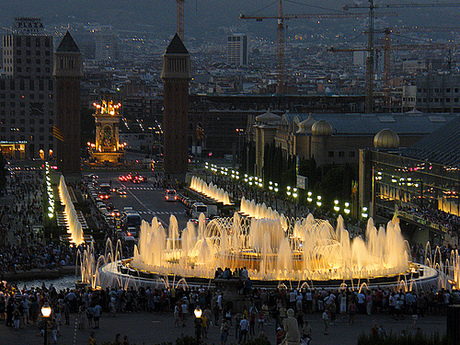Magic Fountain
The Magic fountain is a large fountain built in 1929. When the fountain is active, it constantly changes color and shape. The Font Màgica or Magic fountain was part of a project built for the 1929 Universal Exhibition. The exhibition took place on Montjuïc, a hill just southwest of Barcelona's city center.
The Magic Fountain was designed by Carles Buigas, who had designed illuminated fountains as early as 1922. The site where the fountain was constructed was the previous location of The Four Columns. The columns, representative of the Catalanism movement, were demolished in 1928 under the rule of Prime Minister Migel Primo de Rivera and were re-erected in 2010 a few meters away from the original location.
Buigas submitted his design a year before the exhibition, with many calling the plan too ambitious, with too little time to complete. The construction project utilized over 3000 workers. The first show took place on May 19, 1929, the day before the start of the Exposition. The fountain was badly damaged in the Spanish Civil War and did not operate until 1955, after Buigas oversaw needed repairs.
The magic fountain of Montjuïc's first performance was on May 19, 1929 during the Great Universal Exhibition. The designer Carles Buigas submitted his plans one year before the exhibition and many thought that the project was too ambitious to be created, let alone completed on time.
Over 3000 workers were commissioned to work on the project and less than 1 year later the magic fountain was born.
The project, designed by the engineer Carles Buïgas i Sans consisted of a series of cascades and fountains between the Palau Nacional, the main exhibition center on the Montjuïc, and the Plaça d'Espanya at the foot of the hill. The project took one year to complete. The most spectacular part was the monumental Magic fountain. It was originally intended to show people what could be achieved with filtered electrical light. After many years of disuse, the fountain was in a bad state, but it was restored for the 1992 Olympic games, which were held on the same hill.
In the 1980s, music was incorporated with the light show and the fountain, along with the Museu Nacional, was completely restored prior to the 1992 Summer Olympics, held at Montjuïc. Performances include film, classical, and modern music, such as The Godfather, The Lord of the Rings, Gladiator, a Spanish zarzuela movement, and "Barcelona" by Freddie Mercury and Montserrat Caballé.
During the summer evenings, when the fountain is activated, it attracts hundreds of visitors who watch the approx. 15 minute spectacular display of light, water and music. At the same time, the Palau National is illuminated, providing a beautiful background. The show runs every thirty minutes. The start and end date depend on the time of the year, but the best time to see the fountain is at sunset.
12 metres wide and with 3,620 water jets that can spout water up to 4 metres high, the Magic Fountain is the central focus of a the now world-famous music and light show that takes place at the foot of Montjuic in the centre of Barcelona.
Located in perfect surroundings for this type of show, it is overlooked by the Palau Nacional with its impressive staircases and waterfalls and itself has views along the avenue running down towards the towers of Plaça d’Espanya.
Shows start on the hour and half hour and begin with the hits of the 70s and 80s including music of Queen, Freddie Mercury and The Eagles to name a few. Later, the music changes and the fountain comes alive to the classics including works by Beethoven and Vivaldi. The combination of the lights, the music and the dancing jets of the fountain make it a surprisingly entertaining and relaxing experience and is a great way of spending a couple of hours before heading out to dinner.
The magic fountain is a spectacular display of colour, light, motion, music and water acrobatics - if you mix all these elements together in just the right combinations, you end up with pure magic! The magic fountain is a "must see" when you come to Barcelona and highly recommended. The light and music performances from October to April take place on Fridays and Saturdays every half-hour between 7:00 and 8:30pm, and from May to September Thursday through Sunday every half-hour between 9:00 and 11:00pm. The closest Barcelona Metro station is Espanya, along Lines 1, 3, and 8. The fountain is one of Barcelona’s biggest tourist attractions and is a great way to chill out and enjoy the Catalan capital’s excellent climate. You can get there via direct flight to Barcelona or to Girona, Reus or Lleida–Alguaire.




